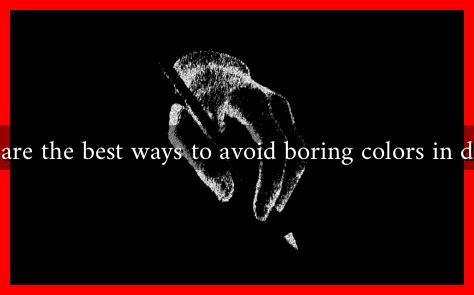-
Table of Contents
- What are the Best Ways to Avoid Boring Colors in Design?
- Understanding Color Theory
- Strategies to Avoid Boring Colors
- 1. Embrace Bold Color Combinations
- 2. Incorporate Textures and Patterns
- 3. Leverage Color Psychology
- 4. Use Color Tools and Resources
- Case Studies: Successful Use of Color
- Conclusion
What are the Best Ways to Avoid Boring Colors in Design?
Color is one of the most powerful tools in design, influencing emotions, perceptions, and even behaviors. However, many designers struggle with choosing colors that are vibrant and engaging rather than dull and uninspiring. In this article, we will explore effective strategies to avoid boring colors in design, ensuring that your projects stand out and resonate with your audience.
Understanding Color Theory
Before diving into practical tips, it’s essential to grasp the basics of color theory. Color theory encompasses the principles of how colors interact, the emotional responses they evoke, and how they can be combined effectively. Here are some key concepts:
- Color Wheel: The color wheel is a circular diagram that shows the relationships between colors. Primary colors (red, blue, yellow) can be mixed to create secondary colors (green, orange, purple).
- Complementary Colors: These are colors that are opposite each other on the color wheel. When used together, they create a vibrant contrast that can energize a design.
- Analogous Colors: These are colors that sit next to each other on the color wheel. They create a harmonious look but can sometimes lack excitement if not used thoughtfully.
Strategies to Avoid Boring Colors
Now that we have a foundational understanding of color theory, let’s explore some practical strategies to avoid boring colors in your designs.
1. Embrace Bold Color Combinations
One of the simplest ways to avoid dullness is to use bold color combinations. Here are some tips:
- Use High-Contrast Colors: Pairing light and dark colors can create a striking visual impact. For example, a bright yellow against a deep navy blue can be eye-catching.
- Experiment with Unexpected Pairings: Don’t be afraid to mix colors that traditionally don’t go together. For instance, teal and coral can create a fresh and modern look.
2. Incorporate Textures and Patterns
Colors can become more dynamic when combined with textures and patterns. Consider the following:
- Textured Backgrounds: Using a textured background can add depth to your color choices. For example, a watercolor texture can soften bold colors and make them more appealing.
- Patterns and Graphics: Integrating patterns can break the monotony of solid colors. Stripes, polka dots, or geometric shapes can add interest and vibrancy.
3. Leverage Color Psychology
Understanding the psychological effects of colors can help you choose hues that resonate with your audience. Here are some examples:
- Red: Often associated with passion and energy, red can be used to grab attention.
- Blue: Conveys trust and calmness, making it a popular choice for corporate designs.
- Green: Represents nature and tranquility, ideal for eco-friendly brands.
By aligning your color choices with the emotions you want to evoke, you can create a more engaging design.
4. Use Color Tools and Resources
There are numerous online tools available that can help you choose exciting color palettes. Some popular options include:
- Coolors: A color scheme generator that allows you to create and explore various palettes.
- Color Hunt: A curated collection of beautiful color palettes for inspiration.
- Adobe Color: A powerful tool for creating color themes based on color theory principles.
Case Studies: Successful Use of Color
To illustrate the impact of vibrant colors, let’s look at a couple of case studies:
- Airbnb: The company’s use of a bright coral color in its branding stands out in the travel industry, evoking warmth and friendliness.
- Spotify: The combination of vibrant green and black creates a modern and energetic feel, appealing to its youthful audience.
Conclusion
Avoiding boring colors in design is crucial for creating engaging and memorable visuals. By understanding color theory, embracing bold combinations, incorporating textures, leveraging color psychology, and utilizing online tools, designers can elevate their work and captivate their audience. Remember, color is not just a visual element; it’s a powerful communicator that can enhance your message and brand identity. So, don’t shy away from experimenting with colors—let your creativity shine!

